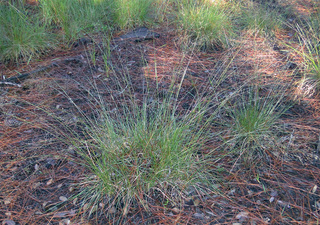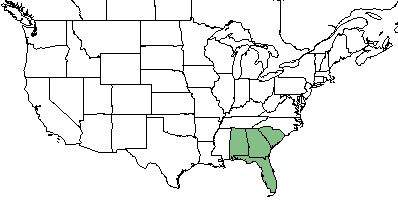Difference between revisions of "Sporobolus floridanus"
Rwagner914 (talk | contribs) (Created page with "{{subst:Template:PlantName}}") |
HaleighJoM (talk | contribs) (→Ecology) |
||
| (18 intermediate revisions by 9 users not shown) | |||
| Line 2: | Line 2: | ||
<!-- Get the taxonomy information from the NRCS Plants database --> | <!-- Get the taxonomy information from the NRCS Plants database --> | ||
{{taxobox | {{taxobox | ||
| − | | name = | + | | name = Sporobolus floridanus |
| − | | image = | + | | image = Sporobolus_floridanus_DL.jpg |
| − | | image_caption = Photo by | + | | image_caption = Photo by Bobby Hattaway hosted at [http://www.discoverlife.org/mp/20q?search=Sporobolus+floridanus&flags=col4: Discoverlife.org] |
| regnum = Plantae | | regnum = Plantae | ||
| divisio = Magnoliophyta - Flowering plants | | divisio = Magnoliophyta - Flowering plants | ||
| − | | classis = Liliopsida - Moncots | + | | classis = Liliopsida - Moncots |
| − | | ordo = | + | | ordo = Poales |
| − | | familia = | + | | familia = Poaceae |
| − | | genus = '' | + | | genus = ''Sporobolus'' |
| − | | species = ''''' | + | | species = '''''S. floridanus''''' |
| − | | binomial = '' | + | | binomial = ''Sporobolus floridanus'' |
| − | | binomial_authority = | + | | binomial_authority = Chapm. |
| − | | range_map = | + | | range_map = SPOR_FLOR_DIST.JPG |
| − | | range_map_caption = Natural range of '' | + | | range_map_caption = Natural range of ''Sporobolus floridanus'' from USDA NRCS [https://plants.usda.gov/core/profile?symbol=SPFL3 Plants Database]. |
}} | }} | ||
| + | Common Name(s): Florida dropseed<ref name="Weakley 2015">Weakley A. S.(2015). Flora of the Southern and Mid-Atlantic States. Chapel Hill, NC: University of North Carolina Herbarium.</ref> | ||
| + | |||
==Taxonomic Notes== | ==Taxonomic Notes== | ||
| − | ==Description== | + | |
| − | <!-- Basic life history facts such as annual/perrenial, monoecious/dioecious, root morphology, seed type, etc. --> | + | ==Description== <!-- Basic life history facts such as annual/perrenial, monoecious/dioecious, root morphology, seed type, etc. --> |
| + | ‘’Sporobolus floridanus’’ is a monoecious perennial graminoid.<ref name="USDA">USDA, NRCS. (2016). The PLANTS Database (http://plants.usda.gov, 10 January 2018). National Plant Data Team, Greensboro, NC 27401-4901 USA.</ref> | ||
| + | |||
==Distribution== | ==Distribution== | ||
| + | ''Sporobolus floridanus'' is endemic to an area from southern South Carolina to peninsular Florida and west through Alabama, but the majority is found in Florida.<ref>Sorrie, B. A. and A. S. Weakley 2001. Coastal Plain valcular plant endemics: Phytogeographic patterns. Castanea 66: 50-82.</ref> It can be found in South Carolina, Georgia, Florida, and Alabama.<ref name="Weakley 2015"/><ref name="USDA"/> | ||
| + | |||
==Ecology== | ==Ecology== | ||
===Habitat=== <!--Natural communities, human disturbed habitats, topography, hydrology, soils, light, fire regime requirements for removal of competition, etc.--> | ===Habitat=== <!--Natural communities, human disturbed habitats, topography, hydrology, soils, light, fire regime requirements for removal of competition, etc.--> | ||
| − | < | + | |
| − | < | + | ''S. floridanus'' has been found in sandy pinelands, pine savannahs, marsh edges, longleaf pine-wiregrass flatwoods, and pine woodlands.<ref name="FSU"> Florida State University Herbarium Database. URL: http://herbarium.bio.fsu.edu. Last accessed: June 2021. Collectors: L.C. Anderson and R.K. Godfrey. States and counties: Florida: Franklin, Gulf, Liberty, Nassau, Wakulla, and Walton.</ref> It is also found in disturbed areas including burned pine flatwoods and powerline corridors.<ref name="FSU"/> |
| + | |||
| + | Associated species: ''Sarracenia, Macbridea, Cuphea, Verbesine chapmanii, Justicia crassifolia, Rhexia, Liatris, Carphephorus, and Helianthus angustifolius, Anthaenantia, Paspalum, Erianthus, Arnoglossum, Eupatorium, and Bigelowia'', and ''Rhynchospora spp''.<ref name="FSU"/> | ||
| + | |||
| + | ''S. floridanus'' is additionally found in wet savannas,<ref name="Weakley 2015"/>, seepage bogs, and titi/cypress swamps and is abundant in wet pine savannas.<ref name="Drewa et al 2002">Drewa P. B., Platt W. J., and Moser E. B. (2002). Community structure along elevation gradients in headwater regions of longleaf pine savannas. Plant Ecology 160(1):61-78.</ref> In north Florida mesic flatwoods ''S. floridanus'' occurred in 53% of plots with a mean coverage of 0.0613 m<sup>-2</sup> and was the sole herbaceous indicator species this community type.<ref name="Carr et al 2010">Carr S. C., Robertson K. M., and Peet R. K. (2010). A vegetation classification of fire-dependent pinelands of Florida. Castanea 75(2):153-189.</ref> | ||
| + | |||
| + | ''Sporobolus floridanus'' is an indicator species for the North Florida Mesic Flatwoods community type as described in Carr et al. (2010).<ref>Carr, S.C., K.M. Robertson, and R.K. Peet. 2010. A vegetation classification of fire-dependent pinelands of Florida. Castanea 75:153-189.</ref> | ||
| + | |||
| + | ===Phenology=== <!--Timing off flowering, fruiting, seed dispersal, and environmental triggers. Cite PanFlora website if appropriate: http://www.gilnelson.com/PanFlora/ --> | ||
| + | ''S. floridanus'' has been observed to flower from June through September.<ref name="Weakley 2015"/><ref name="PanFlora">Nelson, G. PanFlora: Plant data for the eastern United States with emphasis on the Southeastern Coastal Plains, Florida, and the Florida Panhandle. www.gilnelson.com/PanFlora/ Accessed: 10 JAN 2018</ref> | ||
| + | |||
| + | ===Seed dispersal=== | ||
| + | This species is thought to be dispersed by gravity.<ref> Kirkman, L. Katherine. Unpublished database of seed dispersal mode of plants found in Coastal Plain longleaf pine-grasslands of the Jones Ecological Research Center, Georgia.</ref> | ||
<!--===Seed bank and germination===--> | <!--===Seed bank and germination===--> | ||
| − | + | ||
| + | ===Fire ecology=== <!--Fire tolerance, fire dependence, adaptive fire responses--> | ||
| + | In Georgia, the percent cover of ''S. floridanus'' increased from 0.4% after one growing season following a burn to 1.0% after 8 growing seasons.<ref name="Lemon 1949">Lemon P. C. (1949). Successional responses of herbs in the longleaf-slash pine forest after fire. Ecology 30(2):135-145.</ref> Populations of ''Sporobolus floridanus'' have been known to persist through repeated annual burns.<ref>Robertson, K.M. Unpublished data collected from Pebble Hill Fire Plots, Pebble Hill Plantation, Thomasville, Georgia.</ref><ref>Platt, W.J., R. Carter, G. Nelson, W. Baker, S. Hermann, J. Kane, L. Anderson, M. Smith, K. Robertson. 2021. Unpublished species list of Wade Tract old-growth longleaf pine savanna, Thomasville, Georgia.</ref> | ||
<!--===Pollination===--> | <!--===Pollination===--> | ||
| − | <!--=== | + | <!--===Herbivory and toxicology===<!--Common herbivores, granivory, insect hosting, poisonous chemicals, allelopathy, etc--> |
| − | <!--==Diseases and parasites==--> | + | <!--===Diseases and parasites===--> |
| + | |||
| + | ==Conservation, cultivation, and restoration== | ||
| − | == | + | ==Cultural use== |
| + | In the past, native peoples would harvest the tiny husk-less grains and grind them into a flour.<ref> Fernald, et al. 1958. Edible Plants of Eastern North America. Harper and Row Publishers, New York.</ref> | ||
| − | |||
==Photo Gallery== | ==Photo Gallery== | ||
<gallery widths=180px> | <gallery widths=180px> | ||
</gallery> | </gallery> | ||
==References and notes== | ==References and notes== | ||
Latest revision as of 18:01, 15 July 2022
| Sporobolus floridanus | |
|---|---|

| |
| Photo by Bobby Hattaway hosted at Discoverlife.org | |
| Scientific classification | |
| Kingdom: | Plantae |
| Division: | Magnoliophyta - Flowering plants |
| Class: | Liliopsida - Moncots |
| Order: | Poales |
| Family: | Poaceae |
| Genus: | Sporobolus |
| Species: | S. floridanus |
| Binomial name | |
| Sporobolus floridanus Chapm. | |

| |
| Natural range of Sporobolus floridanus from USDA NRCS Plants Database. | |
Common Name(s): Florida dropseed[1]
Contents
Taxonomic Notes
Description
‘’Sporobolus floridanus’’ is a monoecious perennial graminoid.[2]
Distribution
Sporobolus floridanus is endemic to an area from southern South Carolina to peninsular Florida and west through Alabama, but the majority is found in Florida.[3] It can be found in South Carolina, Georgia, Florida, and Alabama.[1][2]
Ecology
Habitat
S. floridanus has been found in sandy pinelands, pine savannahs, marsh edges, longleaf pine-wiregrass flatwoods, and pine woodlands.[4] It is also found in disturbed areas including burned pine flatwoods and powerline corridors.[4]
Associated species: Sarracenia, Macbridea, Cuphea, Verbesine chapmanii, Justicia crassifolia, Rhexia, Liatris, Carphephorus, and Helianthus angustifolius, Anthaenantia, Paspalum, Erianthus, Arnoglossum, Eupatorium, and Bigelowia, and Rhynchospora spp.[4]
S. floridanus is additionally found in wet savannas,[1], seepage bogs, and titi/cypress swamps and is abundant in wet pine savannas.[5] In north Florida mesic flatwoods S. floridanus occurred in 53% of plots with a mean coverage of 0.0613 m-2 and was the sole herbaceous indicator species this community type.[6]
Sporobolus floridanus is an indicator species for the North Florida Mesic Flatwoods community type as described in Carr et al. (2010).[7]
Phenology
S. floridanus has been observed to flower from June through September.[1][8]
Seed dispersal
This species is thought to be dispersed by gravity.[9]
Fire ecology
In Georgia, the percent cover of S. floridanus increased from 0.4% after one growing season following a burn to 1.0% after 8 growing seasons.[10] Populations of Sporobolus floridanus have been known to persist through repeated annual burns.[11][12]
Conservation, cultivation, and restoration
Cultural use
In the past, native peoples would harvest the tiny husk-less grains and grind them into a flour.[13]
Photo Gallery
References and notes
- ↑ 1.0 1.1 1.2 1.3 Weakley A. S.(2015). Flora of the Southern and Mid-Atlantic States. Chapel Hill, NC: University of North Carolina Herbarium.
- ↑ 2.0 2.1 USDA, NRCS. (2016). The PLANTS Database (http://plants.usda.gov, 10 January 2018). National Plant Data Team, Greensboro, NC 27401-4901 USA.
- ↑ Sorrie, B. A. and A. S. Weakley 2001. Coastal Plain valcular plant endemics: Phytogeographic patterns. Castanea 66: 50-82.
- ↑ 4.0 4.1 4.2 Florida State University Herbarium Database. URL: http://herbarium.bio.fsu.edu. Last accessed: June 2021. Collectors: L.C. Anderson and R.K. Godfrey. States and counties: Florida: Franklin, Gulf, Liberty, Nassau, Wakulla, and Walton.
- ↑ Drewa P. B., Platt W. J., and Moser E. B. (2002). Community structure along elevation gradients in headwater regions of longleaf pine savannas. Plant Ecology 160(1):61-78.
- ↑ Carr S. C., Robertson K. M., and Peet R. K. (2010). A vegetation classification of fire-dependent pinelands of Florida. Castanea 75(2):153-189.
- ↑ Carr, S.C., K.M. Robertson, and R.K. Peet. 2010. A vegetation classification of fire-dependent pinelands of Florida. Castanea 75:153-189.
- ↑ Nelson, G. PanFlora: Plant data for the eastern United States with emphasis on the Southeastern Coastal Plains, Florida, and the Florida Panhandle. www.gilnelson.com/PanFlora/ Accessed: 10 JAN 2018
- ↑ Kirkman, L. Katherine. Unpublished database of seed dispersal mode of plants found in Coastal Plain longleaf pine-grasslands of the Jones Ecological Research Center, Georgia.
- ↑ Lemon P. C. (1949). Successional responses of herbs in the longleaf-slash pine forest after fire. Ecology 30(2):135-145.
- ↑ Robertson, K.M. Unpublished data collected from Pebble Hill Fire Plots, Pebble Hill Plantation, Thomasville, Georgia.
- ↑ Platt, W.J., R. Carter, G. Nelson, W. Baker, S. Hermann, J. Kane, L. Anderson, M. Smith, K. Robertson. 2021. Unpublished species list of Wade Tract old-growth longleaf pine savanna, Thomasville, Georgia.
- ↑ Fernald, et al. 1958. Edible Plants of Eastern North America. Harper and Row Publishers, New York.